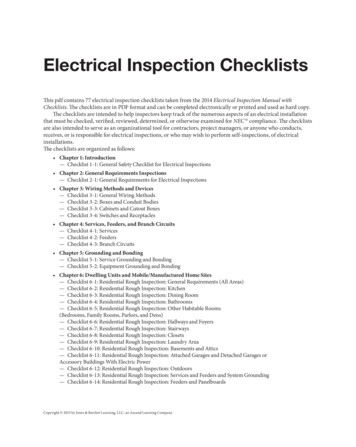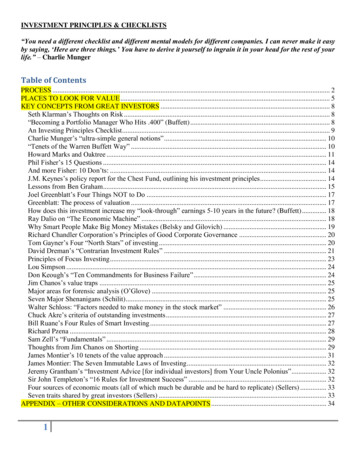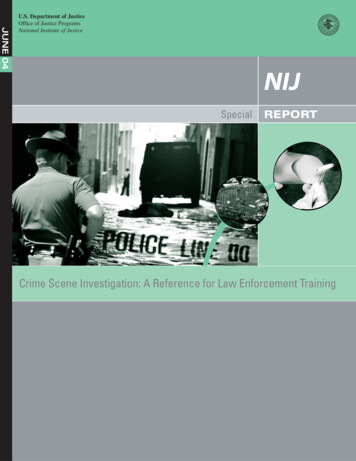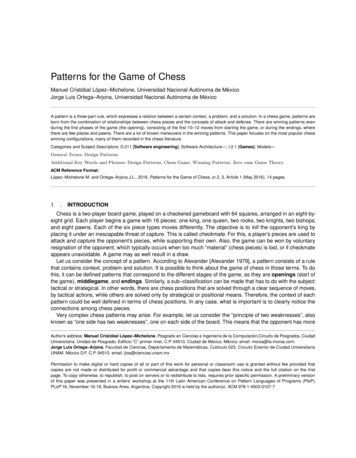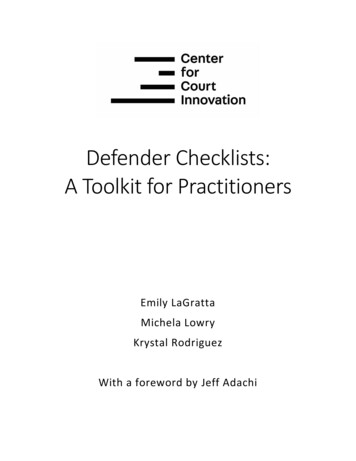
Transcription
Defender Checklists:A Toolkit for PractitionersEmily LaGrattaMichela LowryKrystal RodriguezWith a foreword by Jeff Adachi
Forewordby Jeff Adachi, San Francisco Public Defender“We are what we repeatedly do. Excellence, then, is not an act, but a habit.” -- AristotleI first came to the subject of checklists after a friend recommended the book “The ChecklistManifesto” by Dr. Atul Gawande. A Harvard Professor and surgeon, Dr. Gawande argues thatmany of the 150,000 deaths that follow surgery every year could have been avoided if surgeonsused a checklist to prepare. From washing one’s hands with soap, to cleaning the patient’s skinwith antiseptic, to continuously checking the patient’s vital signs, Dr. Gawande discovered thatfailures in following essential procedures could be traced back to in at least half of the deathsdocumented. He concluded that checklists provide protection against such failures. “Theyremind us of the minimum necessary steps and make them explicit. They not only offer thepossibility of verification of also instill a kind of discipline of higher performance.”It turns out checklists work just as well for defense attorneys and public defenders, who are constantlyjuggling a myriad of tasks requiring a unique blend of research, investigation, experience, knowhow and creativity. Whether a case requires us to file a motion to suppress evidence, or designan investigation plan for a mistaken eyewitness identification defense, we are called on toperform a series of complex steps we must complete in order to prepare our case and achievethe outcome we seek for our client. The outcome in a particular case depends on how well andeffective each of those tasks is carried out.Enter the checklist, which provides a host of benefits to both attorneys and clients while improving caseoutcomes. Checklists Combat Complexity. Because the work of a defense attorney is becomingincreasingly more complex, it is very difficult to master every situation or legal problemthat presents itself. Even an experienced lawyer must rely on the advice of others inhandling unfamiliar problems or subjects. The law is constantly changing and there arealways new issues of which to stay abreast, and new procedures which must be learnedand applied, often in a short period of time. Checklists Prevent Mistakes. Checklists ensure attorneys don’t have to rely solely upontheir memories or experience to handle a particular legal problem. In our office, weregularly conduct post-mortem examinations of our failures. We find, in most cases, ourmissteps and oversights could have been avoided by using checklists.As San Francisco Public Defender, part of my job is to work with my staff to ensure that we aredoing everything that should be done for every client and every case. So I decided to test Dr.Gawande’s assertions and began a mini-checklist revolution in our office.The subjects we attacked in the resulting checklists were our most common, from investigationof certain types of cases, such as eyewitness identification, to case preparation, such as working
up a case for trial, and even simple court procedures, such as arraigning a client. We assignedthe task of creating checklists to those who had substantial experience in the area, but we alsohad attorneys who did not have the experience review the checklist to see if they were able tocomprehend it. Then, as Dr. Gawande advises in his book, we tested the checklists by havingpeople use them and then revised them as we learned more. Dr. Gawande calls this process“validating” the checklist, and it is essential to ensuring that the checklist works and isconstantly updated.I realize that public defenders may often feel overwhelmed by high caseloads and too manytasks to do. Some have told me, “I don’t have time to organize a checklist!” But by having achecklist, defenders can better prioritize and keep track of what is done and what needs to bedone on a case, and manage tasks more efficiently. Checklists also will help chief defendersillustrate to funders and boards the specific tasks that need to be performed on various types ofcases.My hope is that other offices will adapt these checklists to fit the needs of their attorneys andclients, and that together, we can have a checklist revolution!
Background: The case for defender checklistsOver the last two decades, national spending on legal assistance has decreased byapproximately 33 percent,1 while public defender caseloads have increased by 20 percent. Threeout of four county-based public defender offices exceed the maximum recommended caseloadper attorney.2 For many public defender offices, this reality has translated into an unwelcomedmandate to do more with less, and it is easy to imagine the impact this has on clientrepresentation. One Minnesota study found that only a little more than half of public defendersagreed that they were well prepared for their cases in the past year.3Strained resources also translate into limited training resources and oversight for thesealready-overtasked defenders, particularly new lawyers. A Nevada report highlights that newattorneys are “being thrown into practice with no training or support having to figure it out for[themselves].”4 The Comprehensive Review of Indigent Defense in Virginia reached similarconclusions: “inadequate resources and an absence of an oversight structure form the basis ofan indigent defense system that fails to provide lawyers with the tools, time and incentive toprovide adequate representation to indigent defendants.”5Adequately funding public defense may not have an easy path forward, but providingmeaningful training resources for defenders is within reach. The San Francisco PublicDefender’s office has developed an innovative approach to create and implement defenderRhode, Deborah. (2012) “Equal Justice Under Law: Connecting Principle to Practice.” Journal of Law & Policy.Farole & Langton, U.S. Department of Justice, Bureau of Justice Statistics, Census of Public Defender Offices:County-based and Local Public Defender Offices, 2007, NCJ 231175 (September 2010).3Junod, Deborah Parker and Starr, KJ. (2010) “Evaluation Report: Public Defender System.” Office of theMinnesota Legislative Audit Commission. Available at ef.pdf.4National Legal Aid and Defender Association (2003) “Evaluation of the Public Defender Office: Clark County.”Clark County, Nevada Final Report. Available athttp://www.nlada.net/sites/default/files/nv evalofpdofficeclarkcountyjseri03-2003 report.pdf5Spangenberg, Robert L. et al. (2004) “A Comprehensive Review of Indigent Defense in Virginia.” American BarAssociation, Standing Committee on Legal Aid and Indigent Defendants. Available e/va report2004.authcheckdam.pdf.12
checklists to better guide its attorneys through key moments in a case. The initiative is foundedin literature – Atul Gawande’s The Checklist Manifesto – that documents the value of checklistsfor complex and overworked systems, such as the legal system:“[T]he volume and complexity of what we know has exceeded our individual ability todeliver its benefits correctly, safely, or reliably That means we need a differentstrategy for overcoming failure, one that builds on experience and takes advantage of theknowledge people have but somehow also makes up for our inevitable humaninadequacies.”6Checklists, Gawande argues, offer a strategy “almost ridiculous in its simplicity,” thatitemize standard actions to be performed in a given setting, so that no step is overlooked.Checklists themselves are designed to combine precision and comprehensiveness with ease andefficiency of use.For example, publicExcerpt from Appendix A: Immigration Checklistdefenders are required to discussimmigration issues with clientswhose case may trigger collateralconsequences. A checklist such asthe one shown in part at right(provided in full as Appendix A)could be used with every client toflag for possible issues. Eachchecklist contains a set of discreteitems, organized as straightforwardcheckboxes (i.e., each6Gawande, Atul. 2009. The Checklist Manifesto. Picador.
recommended action either was completed or not), which can be quickly digested, assessed, andreviewed as applicable.The benefits of using checklists have been studied extensively in the medical andaeronautics field. In aeronautics, the complexity of today's aircraft requires a systematicapproach to operations. The aircraft checklist has long been regarded as the foundation of pilotstandardization and cockpit safety, and the improper use, or non-use, of the standard industrychecklist by flight crews is often cited as the probable cause or at least a contributing factor inaircraft accidents.7In recent years, efforts to reduce complications in surgery and intensive care units, too,have led to successful quality improvement initiatives using checklists. Checklists have beenshown to improve care and reduce morbidity and mortality in healthcare settings. A 2008 studyof eight hospitals around the world, found the implementation of checklists reduced majorsurgery complications by 36 percent and deaths by almost 50 percent.87Degani, A., & Wiener, E. L. 1993. Cockpit checklists: Concepts, design, and use. Human Factors, 35(2), 345-359.Weiser T G, Regenbogen S E, Thompson K D, Haynes A B, Lipsitz S R. others. 2008. “An Estimation of theGlobal Volume of Surgery: A Modelling Strategy Based on Available Data.” The Lancet 372 (9633): 139–44.8
Given the limited-capacity, high-need situation of public defenders described above, checklistliterature suggests a number of questions. Could any of these benefits be captured for defenders,who like pilots and doctors, must make hundreds of life-altering decisions in a given day, oftenwith significant time and resource constraints? What decision points might be appropriate? Howwould interested agencies generate buy-in and feedback about this new resource? Whatoutcomes might these agencies expect to measure to gauge success? This toolkit aims to helpinterested jurisdictions answer those questions and chart a course for implementation.
Step 1: PlanningThe San Francisco Public Defender’s Office paved the way by developing a number of checkliststhat address matters of substantive U.S. Constitutional law or practical matters that are relevantto defenders nationally, such as flagging collateral immigration consequences or best practicesfor interviewing eye witnesses. Some of these checklists are included as Appendices A – D forreference and adaptation. But lessons from other fields – and from San Francisco itself – showthat engaging the professionals who will be asked to implement the checklists is essential.Whether you are building upon existing models or developing new checklists, successfulimplementation will require planning to ensure that the effort itself is well-designed and has theresources and buy-in needed to carry through to implementation. Expect this planning process torequire the dedication (and time) of senior leadership and a capable attorney serving as a projectmanager for at least six to nine months. Recommended planning steps are outlined as follows.A) Get staff involved: Anticipate a range of receptivity to the concept of defenderchecklists, including a healthy dose of skepticism from many. Many professionals find ituncomfortable to discuss shortcomings in their practice; others will resist the implication thatsomething as simple as a checklist could improve their practice. In the early days ofimplementing checklists in San Francisco, senior attorneys, in particular, resisted the checklists.Engaging a range of staff from the beginning may help to solicit these concerns from the startand help to generate their support of the effort going forward. Include attorneys at all levels,including new attorneys, supervising attorneys, and attorneys with specialized roles (e.g.arraignments), as well as non-attorneys, such as case managers, investigators, and paralegals.Even if some of these individuals will not be involved in pilot testing the checklists, they will allhave valuable perspective on the question of how and when checklists might be useful.
San Francisco used a combination of informal one-on-one meetings, group meetings, andexisting trainings, to get staff feedback. The format should match the office’s culture, as well asthe time and schedule constraints of its staff. Consider whether attendance by agency leadershipwould inhibit lower-level staff’s candor when discussing the topic and convene them separatelywhen necessary.Possible discussion questions: What topics/questions are easy to miss in the typical client interaction or casepreparation? What issues are easy to misdiagnose? What steps or lines of inquiry are defenders finding difficult to remember? What issues are most commonly overlooked by supervisees? Which moments in a case are the most rushed and therefore susceptible to error? Which moments in a case are the most difficult procedurally and thereforesusceptible to error? Which moments in a case are the most difficult in terms of substantive law andtherefore susceptible to error?A critical outcome of this discussion will be to gain consensus internally about whatproblem(s) you hope that checklists would solve. Some possible answers: addressing knownerrors in client communication or legal representation, or perhaps more likely, a mere suspicionof such, or addressing new legislation or procedural rules that are unfamiliar to attorneys. In anycase, the objective of the checklist(s) should be clear and responsive to specific needs. Considerusing one or more sample checklists to help guide the discussion and make it more focused.Additionally, be sure to get feedback from staff about what the pilot period could looklike. Who should participate and for how long? Should participation be voluntary or mandatory?
What opportunities will there be for defenders to give feedback about the checklists’ content andhow they were implemented?As mentioned above, you should anticipate that professionals (particularly the moreseasoned ones) may take offense at the suggestion that their complicated responsibilities can beboiled down into a tidy checklist. This happened when checklists were implemented withsurgeons and pilots, too.Possible push-back or criticism to anticipate: Checklists feel like administrative workShort checklists are perceived as too obviousLong, detailed checklists are too cumbersomeIndependence of attorneys; resistance to top-down initiativeMuch of this criticism can be addressed by ensuring that senior members of the agency are onthe first line of testing new checklists. Also, the more that the planning discussion explores thesepoints of criticism openly, the more likely you are to dispel these concerns.B) Get client feedback: Research shows that perceptions of fairness and understandingof the process can be far more predictive of client satisfaction than the case outcome itself.Consider whether there’s a role for client feedback in this process, too. How might clients help atthe planning stage to answer questions like: what aspects of their representation seem mostconfusing or might benefit most from a more clearly delineated process? What do they perceiveto be the points of case preparation that are most susceptible to error? These conversations won’tbe dispositive, but they will be informative and help to build support for future implementation.Also, discussing the checklist concept with clients early on may also help to ease potentialdefender concerns that using checklists will give clients reason to lose faith in defenders’abilities.Suggested strategies for talking with clients:
Conduct an informal survey with select clients Host a voluntary focus group at the office Conduct a more rigorous client surveyC) Crunch the numbers: Consider what data is available that may inform potentialproblems that checklists could address.Data to consider: Pretrial outcomes, including bail decisions Motion practice outcomes Number and types of motions filed Case processing measures Case dispositions SentencesThese types of data are influenced by many factors, many beyond the control of the defender, butthey may reveal issues that could be helped by this process.Step 2: Drafting and piloting testDrafting checklists is a recipe of equal parts content, format, and implementation planning.What’s on the checklist? How and when will the checklist be used? What would make thechecklist user-friendly and most likely to be adopted by staff? What might safeguard against staffresistance? These issues are explored below.A) Develop the checklist content: Initial planning should reveal a number of practiceareas that might benefit from a checklist. The topics to be covered on the checklists should coverthe problems areas attorneys identified as most appropriate for use of a checklist. Somesuggestions:
Possible topics or touchpoints Initial client interview Motions practice and/or tracking what hearings to request Elements of specific hearing types Discrete trial issues Sentencing procedures Client communication on topics that could include: immigration status; policeinteraction; mitigating factors; fact finding questions; sentencing Highly technical areas (e.g. forensic sciences)Once the substantive content is developed, consider these guidelines adapted from The ChecklistManifesto.1) Be precise and practical.For example, a checklist item stating “Investigate the immigration consequences for yourclient” is too broad. Unpack these broad steps into bite sized steps. (See Appendix A, fora sample Immigration checklist.)2) Make it short and implement it at a clear pause point.Aim for each checklist to contain fewer than ten elements, if possible. Asking more ofbusy attorneys may reduce adoption and usage. It should also be utilized at a point in thecase with a natural “pause point.” Possible pause points include: after client interview,before negotiating plea with the prosecutor, or before talking to the client aboutconsequences.3) Keep it simple and exact.
For example, a draft checklist may have an item asking: “Is the client in custody onexcessive bail?” Make sure that “excessive bail” is clearly defined.The checklist cannot be lengthy. A rule of thumb some use is to keep it tobetween five and nine items, which is the limit of working memory.The Checklist Manifesto, p. 123At the end of each checklist, consider what the analysis or action item should be. For example, atthe end of an evidentiary checklist, consider a final step to be: “If there was a problem with thecollection or maintenance of the evidence, file a motion challenging its admissibility.”2B) Choose a format that is user-friendly: The formatting of the checklist itself should beconducive to the workflow of busy defenders.Good checklists are precise. They are efficient, to the point, and easy to useeven in the most difficult situations.The Checklist Manifesto, p. 120Consider whether a hard copy or electronic version would be most user-friendly andtherefore easiest to adopt. Free software is available to help create the checklists.9 Also considerpractical design resources and barriers. Does your office have easy access to a color printer or9See, for example: http://printablechecklist.org/; es/checklist-template.pdf; and te.html.
should checklists be designed in black and white? Can and should any checklist answersprepopulate other systems in use by the office so as to minimize redundancies?[A] checklist cannot fly a plane. Instead, they provide reminders of only themost critical and important steps- the ones that even the highly skilledprofessionals using them could miss. Good checklists are, above all, practical.The Checklist Manifesto, p. 120Checklists can help reinforce other agency priorities, such as using plain language withclients. If attorneys aim to avoid acronyms and legalese when talking with clients, checklists tooshould avoid those terms so the client understands the question being asked. For example, asking““Did you do a cold show?” could be more helpful by defining “cold show.” Checklist wordingcan also help remind the lawyer to explain this term of art in plain language.The tone and word choice should also be respectful of clients and the process. “Is theclient from an overbearing family?” should be rephrased. This question is subjective as wordedand does not clearly communicate the objectives of this checklist item.Consider organizing or labeling the checklists by governing law or what stage in the caseit would be most useful. You could also consider whether separate decision tree worksheetsshould be developed to complement the checklists or whether the checklists can guide attorneysthrough the possible pathways.
C) Plan for implementation: When you are ready to plan your checklist pilot test, returnto the goals of the initiative. Consider opportunities to lighten the workload of those participatingin the pilot to acknowledge the extra effort they’re putting in. Also consider professionaldevelopment and leadership opportunities (e.g., leading future trainings) that could flow fromthis experience.Note that when tested in the medical field, checklists were most successful when tested initiallyby professionals with the seniority (and patience) to make the necessary changes.All pilot participants should be trained before the pilot starts. Sample training materialsare available as Appendix E. Offices with horizontal representation may pose challenges unlessall attorneys are trained.Consider having a control group of attorneys at the implementation stage, who do not usethe checklist. The purpose would be to compare their performance, memory and effectiveness inthe checklists’ subject matter, to other attorneys who worked with the same subject matterwithout the benefit of the checklist.10Expect some speed bumps as the pilot launches, including additional pushback or lack ofadoption. Offer opportunities for both staff and clients to give feedback during the pilot period toensure that their concerns are heard. Continuing this feedback loop will improve the content anddelivery itself, as well as generate additional buy-in for the project. You will also want tomonitor usage regularly to detect whether all pilot participants are in fact participating, toreengage those whose participation may have waned.Gawande, Atul. “When Checklists Work and When they Don’t.” The Incidental Economist, Publisher (onlyinclude this information if it is different than the name of the blog site), March 15, cklists-work-and-when-they-dont/10
Step 3: Measuring changeAfter investing time and energy into implementation, all involved will want to know what impactthe checklists are having. The results of using checklists can be meaningfully evaluated, onlyafter they have been substantially implemented. San Francisco was able to conduct an initialreview of their checklist implementation efforts using staff surveys and facilitated conversationswith staff members regarding perceptions of the checklists, including strengths, weaknesses, andextra time demands (if any) involved in adhering to the checklists. The full research report isavailable here.Admittedly, tracking outcome data – like whether defendants’ cases were dismissed moreoften or they experienced more favorable sentences – is far more challenging and influenced bymany variables outside of the checklist project. However, it’s worth considering the following asa means of demonstrating the project’s impact.A) Measure whether checklists were used: Tracking usage presents the first hurdle.Develop a method to know whether attorneys are 1) actually using the checklist and 2) using thechecklists as intended. If direct observation is not possible by supervisors or even by junior teammembers or interns, a staff member could review completed forms in case files or consider othermeans for completed checklists to be submitted for review.
B) Measure whether checklist usage changed the knowledge, attitudes, andbehaviors of the attorneys who used them: It may also be useful to track whether attorneyshave changed their approach to certain practice areas or checklists. Have they become moreaccustomed to using checklists? Do they prefer some checklists over others? Are initiallyresistant attorneys finding the checklist useful? One survey question for consideration that wasasked among medical professionals implementing checklists: “if you were having an operation,would you want the checklist to be used?” Assess current practices among newer employees, soyou can measure outcomes post implementation.C) Consider whether case outcomes or other outputs have changed: There are manyvariables that affect a case outcome – and many definitions of a “good” case outcome as well.But it is worth considering what objective outputs or outcomes might be tracked as part of yourchecklist pilot. Are there certain types of errors – e.g. missed opportunities to file a motion – thatcould help tell the story of how the checklists changed defender practice?Questions to consider when assessing checklists include: Are the outcomes related to the purpose of your program or plan? Is it within your control to influence outcomes? Are your outcomes realistic and attainable? Have you moved beyond satisfaction in your outcomes? Is there a logical sequence among your short-term, intermediate and long-termoutcomes? Are there any “leaps” in your outcomes (i.e., gaps in progression of impacts)?11“Checklists for Measuring Outcomes.” Available athttps://eca.state.gov/files/bureau/measuring outcome checklist.pdf (last visited Mar. 22, 2018). EvaluationDivision, Bureau of Educational and Cultural Affairs, U.S. Department of State.11
Step 4: Review, revise, and roll outChecklists must not become ossified mandates that hinder rather than help.Even the simplest requires frequent revisitation and ongoing refinement.The Checklist Manifesto, p. 174Just as in the beginning of the pilot, ongoing engagement with those who participated in the pilotis important to solicit feedback about the content, format, and implementation of the checklists.Have the needs of the office changed? Has the substantive or procedural law changed, requiringnew content to be considered? Consult with internal and external experts to answer thesequestions. Are there format changes that would make the checklists more user-friendly? Howwould office-wide roll out work? How can the checklists be incorporated into existing trainingsfor new and existing staff? This iterative process will help ensure that the checklists surviveleadership change, staff turnover, and other changing priorities of the agency.
ConclusionChecklists aren’t the answer to many challenges that public defender offices face. Thosechallenges are significant. But they may help address training and supervision gaps and serve asa tool to improve practice. They also give defenders new metrics by which to measure theirimpact, which might help in their efforts to address more systemic barriers to the public defensesystem.For more information about how checklists have been implemented in San Francisco,CA, please visit http://sfpublicdefender.org/services/checklists. For more information about otherimprovements to the criminal justice system, please visit www.courtinnovation.org.
APPENDICES A – E: Sample checklistsWhat follows are a number of sample checklists developed by the San Francisco Public DefenderOffice. In considering whether one or more may be right for your office, review:1.2.3.4.What local problem would this checklist solve?What parts of the included content are applicable? What local adaptationsor edits are needed?What process would be needed to make any needed edits or adaptations?Are there language or format changes that would make the checklist(s)more accessible to and user-friendly for local attorneys?
APPENDIX AImmigration StatusWHICH cases: Every case, every client.WHEN to use: Fill out the checklist while talking to your client about his/her background.Ask your client the following questions:Were you born in the U.S.? Yes NoIf yes, then there are no immigration consequences because the client is a U.S.citizen.If no, ask your client all of the following questions:Have you ever had, or do you now have, any legal status, including: Lawful Permanent Resident (LPR)? Yes No Temporary Protected Status (TPS)? Yes No Deferred Action for Childhood Arrivals (DACA)? Yes No Deferred Action for Parental Accountability (DAPA)? Yes No What is your Nationality? What is your Country of Origin? How long have you been in the United States?Have you ever been deported from the U.S.? Yes NoIf yes, list the approximate date of each deportation:Continued
Do you have a parent, spouse, or child in the U.S. that has any legal status? Yes NoIf yes, list all such persons:Do you have an alien registration number? Yes NoIf yes, what is it?Do you have an immigration attorney? Yes NoIf yes, what is his/her contact information?NEXT STEPS: If your client was not born in the U.S., use the information above to research theimmigration consequences of any disposition of the criminal case.
APPENDIX BInterviewing an EyewitnessWHICH cases: Every case where there is an eyewitness to the incident.WHEN to use: Fill out the checklist while meeting with the eyewitness.To determine the series of events, ask the eyewitness all of the following. What were you doing just before the incident? What were you doing earlier in the day? What exactly did you see happen? What was the first thing that caught your attention?Was
A checklist such as the one shown in part at right (provided in full as Appendix A) could be used with every client to flag for possible issues. Each checklist contains a set of discrete items, organized as straightforward checkboxes (i.e., each 6 Gawande, Atul. 2009. The Checklist Manifesto. Picador. Excerp
